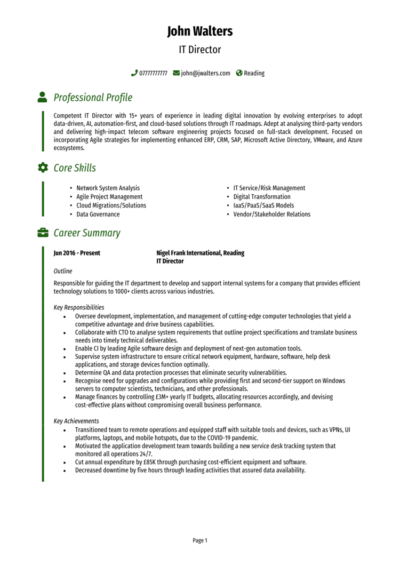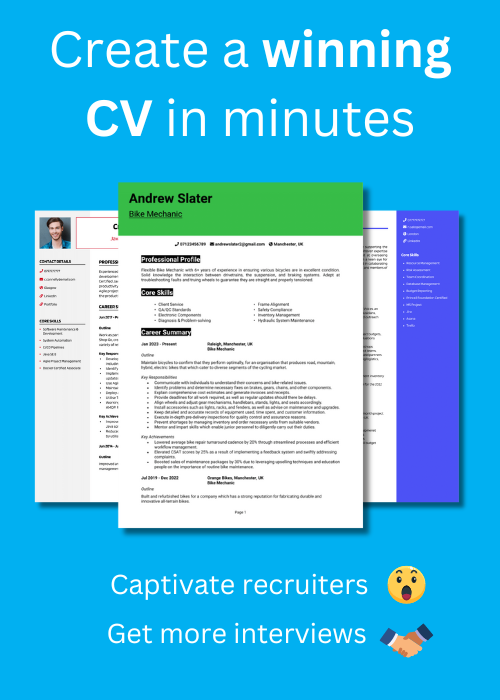When it comes to tech leadership, it’s not just about overseeing servers or managing teams – it’s about shaping the digital backbone of an entire organisation. That means your CV needs to convey more than just your career history.
If you’re aiming for an executive-level role in IT, your CV must demonstrate how you lead transformation and align technology with business goals. This guide will show you how – complete with 2 IT Director CV examples and expert writing advice.
IT Director CV example
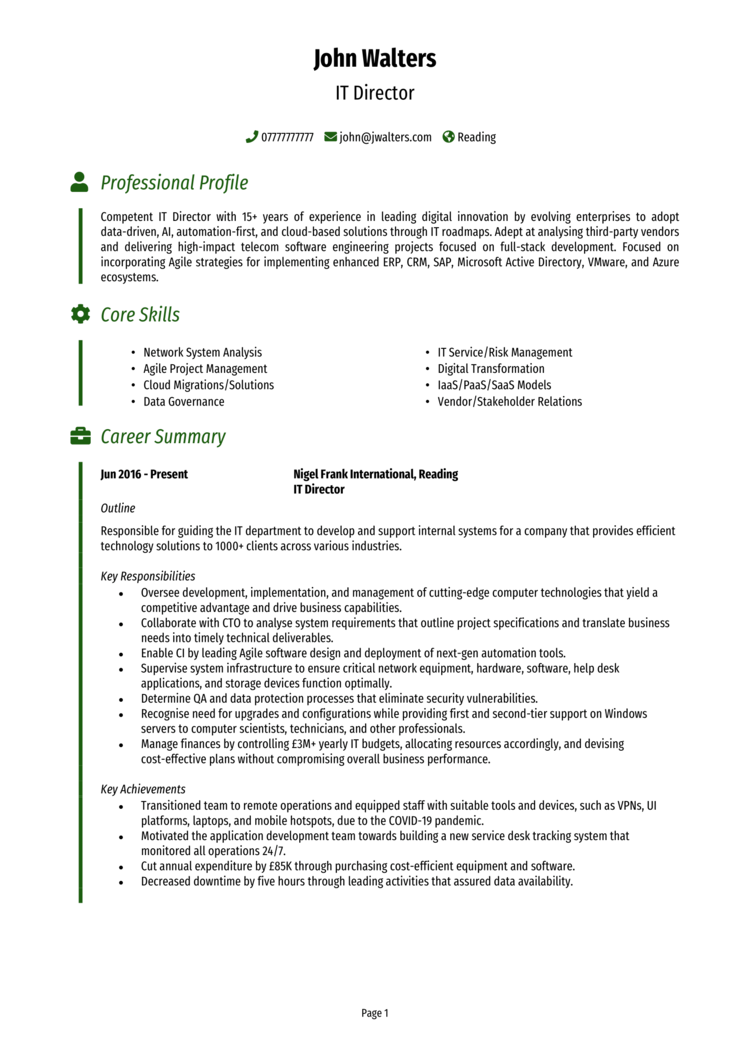
Head of IT CV example
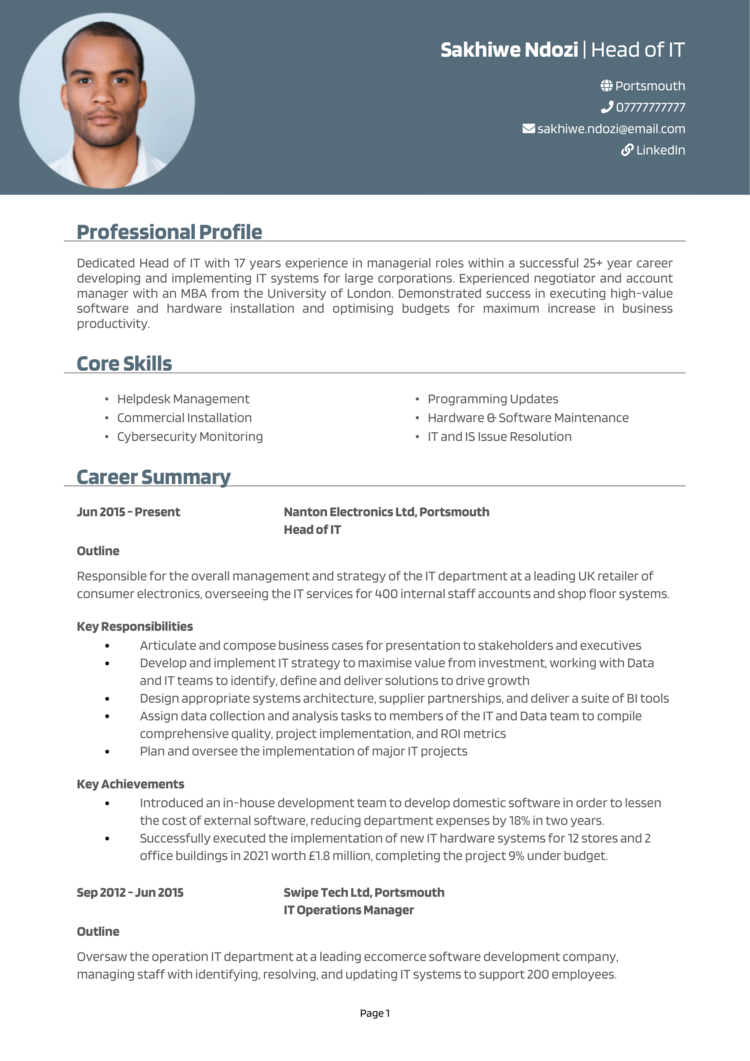
How to write your IT Director CV
Discover how to craft a winning IT Director CV that lands interviews with this simple step-by-step guide.
In an IT Director CV, clarity matters just as much as capability. This guide will walk you through writing a CV in a way that appeals to executive recruiters and decision-makers alike.
You’ll learn how to lay out your CV cleanly and effectively highlight the results you’ve delivered: you’ll prove to recruiters that your leadership makes businesses better – not just systems.
The best way to structure and format your IT Director CV
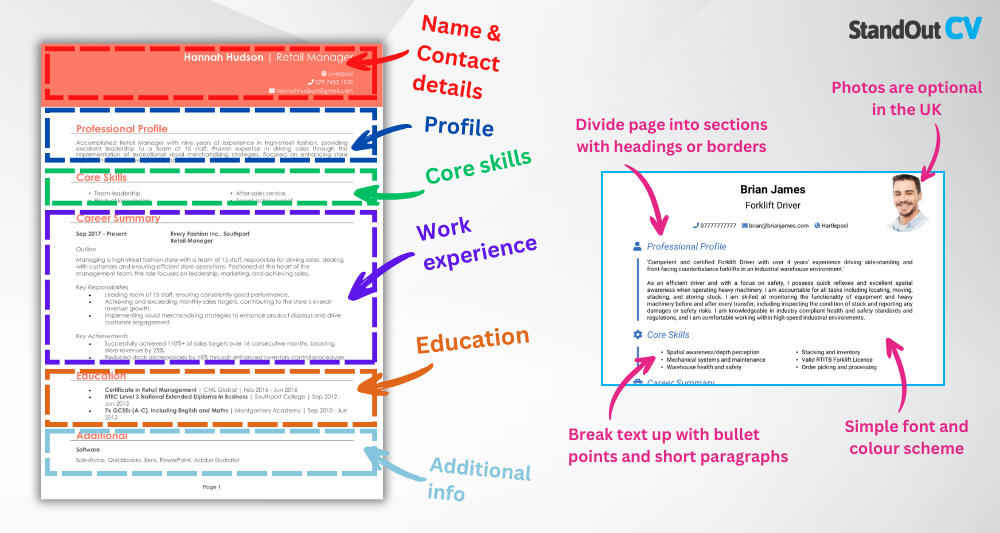
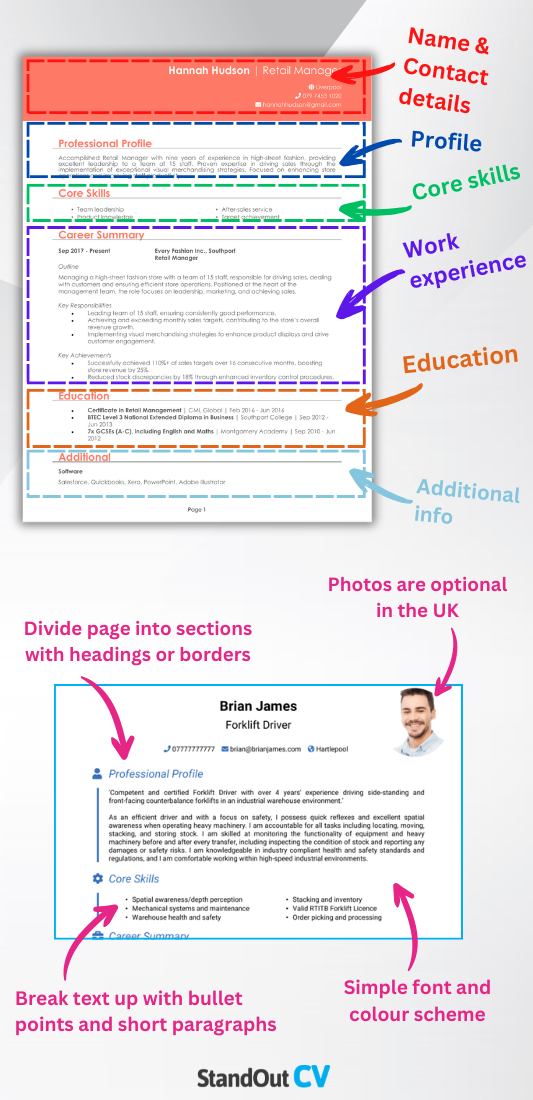
If your CV layout looks like bad code, no one’s going to run it. You’ll want your CV to reflect the same structure and efficiency you bring to a business’s technology stack. If your expertise and experience are buried in jargon or lost in a chaotic format and mistakes, your leadership will be overlooked.
Here’s the layout to follow:
- Name and contact details – Place your name and personal details prominently at the top of your CV for quick access. Adding a photo is up to you.
- Profile – Open with a compelling overview of your skills, experience, and career goals.
- Core skills – List your key abilities in this section, focusing on those that will be most relevant to the job.
- Work experience – Provide a detailed breakdown of your work history, starting with the most recent job first.
- Education – List your qualifications, including degrees and relevant certifications, in reverse chronological order.
- Additional info – Use this optional space for relevant hobbies or personal pursuits that enhance your application.
Make it easy to read: stick to clean fonts and clearly divide your sections. Don’t drown your value in dense text: break down each section with clear bullet points. Stick to a maximum length of two pages, and ensure your formatting is consistent and professional throughout.
What is an IT Director CV profile?


This section is your headline statement – the first place a board-level recruiter or executive stakeholder will look. Your CV profile gives them a quick overview of who you are and what you can do. It’s where you prove your leadership, vision, and above all else, the value you’d bring to any organisation.
Rather than listing systems or buzzwords, focus on how you align technology with commercial strategy and lead high-performing teams.
IT Director CV profile examples
Profile 1
Experienced IT Director with over 15 years of leadership experience in financial services and enterprise technology environments. Proven track record in shaping IT strategy, managing digital transformation projects, and leading cross-functional teams across infrastructure, security, and software delivery. Skilled in aligning technology with business goals and optimising ROI on IT investments.
Profile 2
Strategic IT Director with 12 years of experience driving IT innovation and operational efficiency for global FMCG and retail organisations. Adept at overseeing IT architecture, vendor relationships, and cybersecurity frameworks. Strong focus on delivering scalable, secure systems to support commercial growth and digital agility.
Profile 3
Results-driven IT Director with a decade of experience managing large-scale technology teams within healthcare and public sector environments. Expertise in cloud migration, data governance, and IT compliance. Known for implementing service delivery models that reduce costs while enhancing performance and resilience.
Details to put in your IT Director CV profile
Here are some tips on what your profile should cover:
- Where you worked – You may have led IT strategy at large corporations, scaling startups, or enterprise-level public sector organisations.
- Your top qualifications – You might hold a BSc or MSc in IT or Computer Science, alongside leadership certifications or ITIL/TOGAF frameworks.
- Essential skills – You may bring expertise in cloud infrastructure, cybersecurity leadership, IT governance, ERP rollouts, and digital transformation.
- Specialisms – Perhaps you’ve led global infrastructure upgrades, unified fragmented tech teams, or steered companies through M&A integration.
- Value delivered – You may have reduced downtime by implementing better DR strategies, improved budget efficiency, enhanced system performance, or delivered enterprise-wide change with measurable ROI.
How to highlight your core skills


This section needs to reflect hard, tangible CV skills – not generic leadership terms. At this level, recruiters expect you to know exactly what systems you’ve implemented and frameworks you’ve used.
Highlight technologies and frameworks relevant to the role, whether it’s hybrid cloud platforms, network infrastructure, DevOps adoption, or ERP lifecycle planning: these are the things recruiters are going to be scanning for when they look at a CV.
This isn’t about listing everything you’ve ever touched – it’s about aligning your top capabilities with the role you’re applying for, ideally echoing the phrasing used in the job spec.
Essential skills for an IT Director CV
- Technology Strategy Development – Defining and executing long-term IT strategies that align with business goals and drive innovation.
- Infrastructure and Systems Oversight – Managing enterprise IT systems, networks, and cloud platforms to ensure performance, reliability, and scalability.
- Cybersecurity Leadership – Implementing robust security frameworks, risk assessments, and compliance protocols to safeguard digital assets.
- Team Leadership and Talent Development – Leading IT teams across functions, mentoring staff, and fostering a culture of continuous improvement.
- IT Budgeting and Cost Control – Managing large-scale IT budgets, optimising resource allocation, and ensuring return on technology investments.
- Digital Transformation Management – Driving adoption of new technologies, tools, and workflows to modernise operations and enhance productivity.
- Vendor and Stakeholder Management – Negotiating with technology providers and aligning IT initiatives with the needs of internal and external stakeholders.
- Enterprise Architecture Planning – Designing and evolving IT architecture to support current operations and future growth efficiently.
- Disaster Recovery and Business Continuity – Establishing systems and protocols to ensure minimal disruption during system failures or crises.
- Regulatory Compliance and IT Governance – Ensuring IT operations adhere to industry regulations, data privacy laws, and internal governance standards.
How to showcase your work experience in your CV


This is where your leadership becomes real. Your work experience should highlight major initiatives you’ve overseen, teams you’ve managed, and improvements you’ve driven – not just the tech, but the business case behind it. Walk through your roles in reverse chronological order.
Begin each one with a short summary of the company and your strategic focus there. Then follow with bullet points detailing your responsibilities and achievements – making it clear how you added value at an organisational level.
How to format previous jobs in your CV correctly

- Outline – Introduce the organisation, the scale of the business (e.g. “global finance firm” or “UK-wide retail network”), and your reporting line (e.g. “Reported to CIO, led cross-functional IT leadership team”).
- Responsibilities – Use power verbs like “spearheaded” and “orchestrated.” For example: “spearheaded ERP overhaul for 20+ international sites” or “orchestrated enterprise cloud migration with zero unplanned downtime.” Mention key tech stacks and leadership scope.
- Achievements – Include the results you delivered: cost savings, performance boosts, uptime improvements, enhanced security, or staff productivity. Use quantifiable results where you can.
Example work history for IT Directors
IT Director | Paragon Retail Group
Outline
Led the IT function for a national retail chain, overseeing technology operations and digital transformation initiatives across 100+ UK stores and e-commerce platforms.
Responsibilities
- Defined and implemented IT strategy aligned with company growth and innovation goals
- Managed a £4M annual IT budget, including procurement and vendor contracts
- Led digital transformation projects including POS upgrades and cloud migration
- Directed teams across infrastructure, cybersecurity, and application support
- Established data governance policies and improved cybersecurity compliance
Achievements
- Reduced IT support tickets by 30% after deploying self-service and automation tools
- Successfully delivered new cloud-based ERP system six weeks ahead of schedule
- Improved network uptime across stores to 99.97% through proactive monitoring
IT Director | Greywell Financial Services Ltd
Outline
Oversaw the entire IT estate for a mid-sized financial services firm, supporting business-critical systems, regulatory compliance, and technology-driven service improvements.
Responsibilities
- Led IT strategy, infrastructure management, and digital project delivery
- Worked with senior stakeholders to identify technology opportunities and risks
- Ensured FCA, GDPR, and ISO 27001 compliance across platforms and processes
- Managed outsourced development partners and cloud service providers
- Planned and tested disaster recovery and business continuity frameworks
Achievements
- Implemented multi-factor authentication, improving security posture by 40%
- Reduced IT operational costs by £250K through vendor consolidation
- Introduced Agile delivery practices, improving project turnaround times by 25%
IT Director | Westcliffe Health Trust
Outline
Directed technology services for a regional NHS trust, ensuring stable delivery of digital systems, IT infrastructure, and electronic patient records across multiple care sites.
Responsibilities
- Led cross-site teams responsible for infrastructure, security, and clinical systems
- Oversaw deployment of EPR system integration and data migration
- Chaired IT governance board and worked with clinical leads on technology planning
- Managed IT risk register and advised board on digital investment priorities
- Liaised with external suppliers, NHS Digital, and regional partners on shared services
Achievements
- Delivered trust-wide Wi-Fi rollout and digitisation of patient notes within 12 months
- Achieved full compliance on NHS DSP Toolkit for two consecutive years
- Improved system uptime to 99.95%, reducing clinical service disruption
Structuring your education section


Your academic and professional training should support your leadership credentials. At this level, most IT Directors will hold a degree in Computer Science, IT, or similar – though extensive experience will carry more weight.
Start with your most recent qualification. Include your degree, institution, and any postgraduate certifications that reinforce your strategic or technical capabilities. If you’ve studied business leadership, include those qualifications in your education section too.
Top qualifications to showcase on an IT Director CV
- BSc/MSc in Computer Science, IT, or Information Systems – A foundational qualification for strategic tech leadership
- MBA or Executive Leadership Programme – Ideal for demonstrating business acumen at board level
- ITIL v4 Foundation or Expert Certification – Supports governance and service delivery experience
- TOGAF Certification – Valuable for architectural planning and enterprise-wide system design
- Certified Information Systems Security Professional (CISSP) – Strong proof of senior-level cybersecurity expertise


